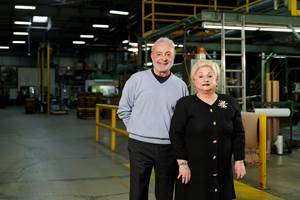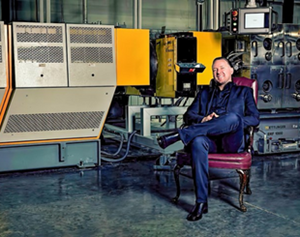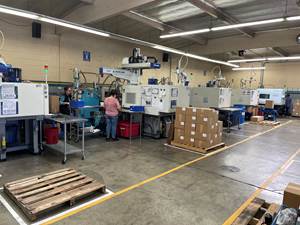Compounder’s Low Headroom Doesn’t Stunt Its Growth
With careful planning and the use of bulk-bag discharging and conveying equipment, The Plastics Group of America was able to accommodate its latest expansion on one level of its 60,000-ft² building.
When The Plastics Group of America decided to invest in more twin-screw compounding capacity at its plant in Woonsocket, R.I., it was restricted by the relatively low ceilings of the building. But with careful planning and the use of bulk-bag discharging and conveying equipment, the company was able to fit everything on one level of its 60,000-ft² building.
The story has roots that go back to 2001, when The Plastics Group (plasticsgroup.com) installed its first twin-screw compounder, a 68-mm machine supplied by Century Extrusion, Traverse City, Mich. (centuryextrusion.com). “We have limited headroom in the plant—14 to 16 ft,” explains Duane T. Delaney, The Plastics Group’s technical manager., so he designed a compounding line where all of the equipment fits on one floor.
The four resin hoppers on the extruder are fed by pneumatic lines from silos. The additive feeding system, though, posed a challenge. Transporting powdered material to a feeder from a remote location by a pneumatic or mechanical system would mean a relatively high cost for the conveyor and installation, as well as more intensive maintenance associated with longer conveyor systems.
Delaney decided that the solution was a bulk-bag discharge system paired with a lower-cost, lower-maintenance flexible screw conveyor installed near the compounding line. The discharger would empty bulk bags into a hopper at its base, and the flexible screw conveyor would convey additives through an inclined tube to a feeder on the compounding line.
Because of the location of the twin-screw extruder, Delaney says, “The 15.5-ft-high discharger could only fit in one place and the twin-screw additive feeder could only be filled in one place. It became obvious that a flexible screw conveyor was a simple, direct system for our needs.” This setup would also be more efficient—and safer—than having workers manually open and empty 50-lb bags of additives into the feeder hopper from a platform.
Integrating the bulk-bag discharger and flexible screw conveyor permitted fillers or reinforcements to be transported quickly to the additive feeder. “The extruders each have five gravimetric feeding systems,” Delaney explains. “One is for additives and the others are for resins. Material must be transported to the additive feeder fast enough to maintain accurate metering.”
Linking the bulk-bag discharger and flexible screw conveyor worked so well that when The Plastics Group specified a second twin-screw line, in 2007, a high-speed 70-mm diam. unit, it ordered another bulk-bag discharger and flexible screw conveyor.
For both installations, the company specified a BFC Bulk Bag Discharger from Flexicon of Bethlehem, Pa. The BFC Discharger has a Spout-Lock clamp ring that attaches the bulk-bag spout to a Tele-Tube telescoping tube. The tube maintains downward tension on the clamp ring, keeping the spout taut and preventing material from bulging out or falling in during discharge and creating flow restrictions.
The original flexible screw conveyor is 6-in. diam, installed at a 35° angle, and transports material 17 ft to the feed hopper. Delaney says that as the flexible screw turns, it self-centers within the plastic outer tube, providing efficient delivery of material to the feeders without damage to the glass fibers and other reinforcements. The second flexible screw conveyor is 4.5 in. diam and runs 27.5 ft at a shallow angle to empty material into the twin-screw extruder’s additive feeder.
Delaney says the flexible screw conveyors each handle 50 to 2000 lb/hr of additives. The company changes material one or two times a day on average. A typical run lasts 18 hr.
Related Content
Generation Gap? Not at Packaging Personified
Started at a kitchen table and now in its third-generation of family involvement, this vertically integrated supplier of flexible packaging traces its success to closely aligning with customers and continually investing in new technology across its films, printing and converting operations.
Read MoreA Recycling Plant, Renewed
Reinvention is essential at Capital Polymers, a toll recycler that has completely transformed its operation in a short period of time.
Read MoreBack in the Family Business
In its 45th year, Precision Molded Plastics has carved out a technology and market niche, growing not just when opportunities arise but when they make sense, after its leader changed careers to keep the family business from changing hands.
Read MoreUS Merchants Makes its Mark in Injection Molding
In less than a decade in injection molding, US Merchants has acquired hundreds of machines spread across facilities in California, Texas, Virginia and Arizona, with even more growth coming.
Read MoreRead Next
Advanced Recycling: Beyond Pyrolysis
Consumer-product brand owners increasingly see advanced chemical recycling as a necessary complement to mechanical recycling if they are to meet ambitious goals for a circular economy in the next decade. Dozens of technology providers are developing new technologies to overcome the limitations of existing pyrolysis methods and to commercialize various alternative approaches to chemical recycling of plastics.
Read MoreHow Polymer Melts in Single-Screw Extruders
Understanding how polymer melts in a single-screw extruder could help you optimize your screw design to eliminate defect-causing solid polymer fragments.
Read MoreTroubleshooting Screw and Barrel Wear in Extrusion
Extruder screws and barrels will wear over time. If you are seeing a reduction in specific rate and higher discharge temperatures, wear is the likely culprit.
Read More


























